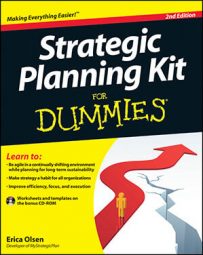By creating these different versions of your strategic plan based on who is going to be reading it, you will see how much easier implementing your plan is when employees have the information they need to execute it. You probably don’t need all these versions, and you may have some special versions based on your company’s needs.
To make your plan a living document, break it up into several versions, such as the following:
The complete version: This document has everything and anything you developed in your strategic planning process (yes, even the kitchen sink!). This version includes all the parts of your strategic plan plus all the support material you collected, such as market research, employee assessments, customer surveys, and so on. Keep all information in one centralized location so you can pull from it in your next planning sessions.
The board version: The board version is best suited for boards and includes just the high-level stuff, such as the mission, vision, values, strategic objectives, and goals. Exclude the measures, responsible persons, action plans, and so on.
The bank version: Banks want a complete strategic plan as well as a narrative description and hard numbers. This version should include
A complete set of financial projections
A one-page executive summary
Bios of key management and staff
A list of key customers or accounts
An explanation of financing needs with supporting assumptions
The management version: A management version of your strategic plan is your scorecard. Your scorecard periodically tracks the key performance indicators (KPIs). Because the KPIs are tied to goals, your management knows whether you’re on strategy. Use those tracking numbers to produce charts and graphs that quickly provide executives with a dashboard of your performance.
The communication version: Strategic planning is as much about articulating a strategic direction as it is getting your staff pulling in the same direction. Communicate your strategic plan through your strategy map. Post the map in the break room or another common area so people are continually reminded of the corporate direction.
The department version: For department managers to implement their portion of the strategic plan, the corporate plan needs to be translated to a department plan.
The individual version: Like with the department managers, individuals need to know exactly what they’re responsible for so they can act accordingly. Creating an individual action sheet, which lists an employee’s goals and action items, is a great implementation tool. You can use the same sheet as a reporting tool for employees to keep managers informed on their progress.
As you make use of various sections of the document, you don’t want to end up with a set of independent strategic plans. Always make sure that all versions point back to the master document.
A company created MyStrategicPlan.com to avoid the issue of versioning and to make it easier to implement a plan by giving people the parts of the plan they’re responsible for. You may find the site useful for your organization and for implementing your own plan.

